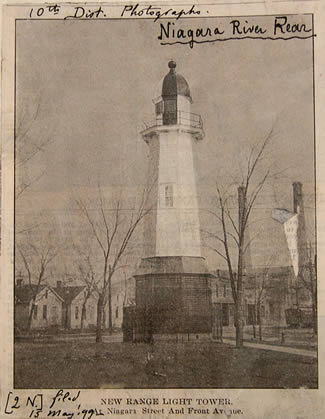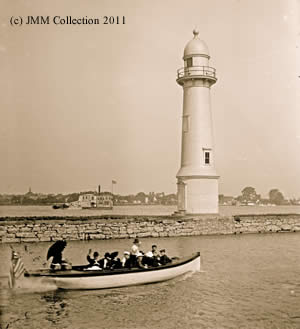Niagara River Rear Range Lighthouse
Buffalo, New York - 1885 (1899**)

History of the Niagara River Rear Range Lighthouse
Posted/Updated by Bryan Penberthy on 2015-01-17.
By the mid-1800s, Buffalo became an increasingly important port on Lake Erie, the Lighthouse Board had recommended to erect a pair of range lights to guide vessels from Lake Erie into the Niagara River. They would become known as the Niagara River Range Lights.
During the 1840s through the 1850s, more than a dozen grain elevators were built in the Buffalo Harbor. This helped fuel the city's growth in the latter half of the nineteenth century, bringing with it a massive influx of shipping traffic.
As vessel traffic into the harbor showed little signs of slowing down, in 1868, the City of Buffalo had started construction of a series of breakwalls to create an outer harbor. By 1884, the Lighthouse Board was looking to establish a set of range lights to guide vessels from Lake Erie into the upper Niagara River.
The following appeared in the Annual Report of the Lighthouse Board in 1884:
Niagara River, New York - Steps were taken towards establishing range lights for the main entrance to the river, and the authorities of the city of Buffalo were asked for permission to erect the proposed mast-lights in the streets of the city, subject to the approval of Congress.
On March 3, 1885, Congress appropriated $250 for the Niagara River Range Lights and the Lighthouse Board issued a notice to mariners that they would be lit for the first time on July 5, 1885. The Annual Report of the Lighthouse Board for 1885 had the following description of the beacons:
691, 692. Niagara River Ranges, on the east bank of Niagara River, New York - Congress, on March 3, 1885, appropriated $250 for the establishment of range lights to guide into the entrance of Niagara River. Permission was obtained from the State canal department and the city of Buffalo to erect masts on the outer bank of the Erie Canal and in the streets of Buffalo. These ranges were completed, and notice to mariners was issued, announcing that they would be ready for lighting on July 5, 1885. They consist of two masts painted white, 28 feet high, and surmounted by circular gridiron day-marks, with slats painted alternately black and white. The masts were provided with locomotive head-lights, and the necessary sheaves for raising and lowering the lanterns, which are held in place by wire guides. The masts have a square wooden platform 10 feet above the base, upon which the lantern is lowered when filled and cleaned.
On December 15, 1885, a contract was made for the construction of the 22-foot by 18-foot one-story frame building on the grounds of the Fort Porter military reservation, which was bounded by Front Ave (now Busti Ave.), Porter Ave, and the Erie Canal. The fort was later demolished in 1929 to make way for the International Peace Bridge, linking Canada and the United States.
The dwelling was to be split in half. One portion of the building was to be used as a boathouse for the keeper of the Horseshoe Reef Lighthouse, just offshore in the Niagara River. The other portion was to be used as a storage house for supplies for the Niagara River range lights.
By 1887, the rear range light, located on Niagara Street was leaning. A bed of concrete, 8 feet in diameter and 3 feet thick, was placed around the base to bring it back to plumb.
Between 1888 and 1889, a row of houses was erected between the front and rear range, obscuring the lights. This led the Lighthouse Board to increase their height. After the adjustments, the front mast-light was shown from 45 feet above the lake, and the rear range was shown from 95 feet above the lake. At that time, the worn-out lamps were replaced with new ones featuring copper reservoirs.
On January 9, 1889, the combination boathouse / storage building on the grounds of Fort Porter was knocked from its foundation during a gale. After some repairs to the stone foundation, it was moved back. Just over one year later, a gale on January 13, 1890 would inflict additional damage to the boathouse, affecting the doors, sides, and stone foundation.
That year, with the deepening and widening of the Niagara River channels, the Lighthouse Board asked for and received permission from the City of Buffalo and the Erie Canal Department to move the lights to new positions to better guide vessels through the improved channel.
The front range was moved in 1890, and by the following year, the old rear range was taken down, and a temporary light was erected further up-stream to range with the front range light. A contract was signed on June 29, 1891 to furnish, deliver, and erect an iron tower to take the place of the temporary rear light.
As most lights were being changed over to the more efficient kerosene in the late 1800s, due to its volatility, an external oil house was needed to safely store the material. In 1892, a circular iron oil house capable of holding 225 gallons of oil was provided for the Niagara River Range Lights.
That year, the new iron tower was erected. The Annual Report of the Lighthouse Board had the following details of the new light:
 Niagara Rear Range Light circa 1899 (NA)
Niagara Rear Range Light circa 1899 (NA)
A permanent rear range tower was erected to take the place of the temporary tower. It is built of iron, is triangular pyramidal in shape, is painted brown, and rests upon a foundation consisting of three brick piers, to which it is securely bolted. It is fitted with hoisting apparatus, which includes a counterpoise weight. A cubby house is in the second lower section for the care of the lighting outfit. An elliptical gridiron day mark, 8 by 12 feet, with slats painted alternately black and white, is on the channel face of the upper part of the tower.
To mark the improved channel, in 1894, the front range was moved to a new structure, 71 feet south of the old site. The Annual Report of the Lighthouse Board described the new structure as "an open framework of wood with a small house at the top for exhibiting the light."
By 1896, the rear beacon was listed as "unsuitable and unsightly" and was scheduled to be replaced by a better beacon, enclosed by an iron fence. As the wheels of government move slowly, it would take two years, but by 1898, the new beacon was designed and the federal government was waiting for a secure title to the site at the corners of Niagara Street and Front Ave (now Busti Avenue).
The new tower was complete by 1899. The Annual Report of the Lighthouse Board had the following description of the new light:
73, 74. Niagara River range, Niagara River, New York - The rear beacon of this range was rebuilt and surrounded by a substantial iron fence. A lens lantern was substituted for the reflector lantern, so that not only is a better light shown at night, but its conspicuousness as a day mark is largely increased. Various repairs were made to the front-range beacon.
The following year, the front range light was rebuilt. Sitting on the Bird Island Pier, the new beacon was circular, painted white, and was provided with a new lens lantern.
As both lights were new, infrequent maintenance was required. In fact, no other entries appear in the Annual Reports of the Lighthouse Board until 1913. That entry states that during the fiscal year 1912, both lights were changed over to acetylene from oil lamps. By 1920, both lights were listed as electric incandescent.
During the late 1800s, plans were being made for the construction of the Black Rock Channel, which would provide a protected channel, walled off from the Niagara River, running from the Buffalo Harbor to Black Rock, allowing vessels heading into the Niagara River to bypass the numerous reefs, rapids, and strong currents.
This new protected channel would be large and deep enough to handle the largest of Great Lakes freighters with a depth of 21 feet and the new lock that was capable of handling freighters up to 650 feet in length.
Construction of the Black Rock Channel and the lock was finished in 1914, effectively letting mariners bypass the dangerous entrance to the Niagara River and diminishing the need for the Horseshoe Reef Lighthouse, which was used to mark the Emerald Channel.
On August 25, 1925, the construction of an international bridge linking Buffalo, New York, in the United States to Fort Erie, Ontario, in Canada, was approved. Construction of the Peace Bridge began that year, and was finished two years later, officially opening to the public on June 1, 1927.
Lights on the Peace Bridge and improvements to the Black Rock Channel led to the decommissioning of the Niagara River Range Lights in 1929. After the rear range light was dismantled, it was barged to Grand Island by Charles and Frank Fix, leading many websites to misreport it one of the Grand Island Range Lights. The front range light, when dismantled, was never seen again.
The fix brothers operated Niagara River cruises, a ferry boat from Tonawanda to Grand Island, which was necessary before the Grand Island bridges were built in 1935, the Bedell House Hotel, and were reported "rum barons" smuggling alcohol from Canada into the United States during prohibition.
The Fix family later sold the lighthouse to Mike Steffen, who used it as a trophy room next to his house. The property on which the lighthouse and his home stood were later annexed to the Buffalo Launch Club, the first power boat club in North America.
Club members restored the exterior in the late 1990s. In 2004, the structure was power-washed to remove bugs and debris, the top was then painted "BLC" blue and a gold lightning arrestor was added. Members spent numerous hours scraping, sanding, and caulking. At that time, vinyl replacement windows were installed near the top of the lighthouse.
The members of the Buffalo Launch Club love the Niagara River and their boats, and it's clear that they will continue to care for the old Niagara River Upper Range Lighthouse to guide them safely back to their "port".While I was visiting there in the year 2000, I spoke with several people who were tidying up the landscape around the lighthouse. The owner of the marina who was nice enough to let me inside and climb to the top of the tower. Click on the "view more pictures" button below to see the pictures.
The front range lighthouse was sometimes referred to the lower range light and the rear range was sometimes referred to as the upper range light.
Reference:
- Annual Report of the Light House Board, U.S. Lighthouse Service, Various years.
- Various Government Documents, Federal & State Governments, Various dates.
- buffalolaunchclub.com website.
- The Buffalo History Gazette website.
Directions: The lighthouse sits on the grounds of the Buffalo Launch Club. From I-190, get off at exit 18 (Beaver Island Parkway) and head south. You will then make a left onto Bush Road and follow that to the end. This will put you right at the Buffalo Launch Club.
Access: The lighthouse is owned by the Buffalo Launch Club. Grounds open. Tower closed.
View more Niagara River Rear Range Lighthouse picturesTower Height: 51.00'
Focal Plane: Unknown
Active Aid to Navigation: Deactivated (1931)
*Latitude: 42.97600 N
*Longitude: -78.94700 W
See this lighthouse on Google Maps.

